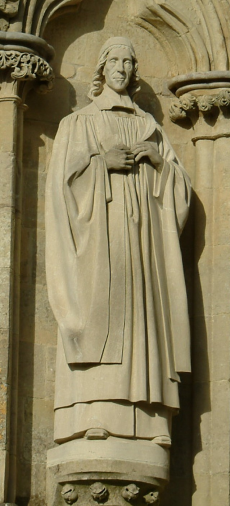
Religion stands on tip-toe in our land,
Readie to passe to the American strand.
When height of malice, and prodigious lusts,
Impudent sinning, witchcrafts, and distrusts
(The marks of future bane) shall fill our cup
Unto the brimme, and make our measure up;
When Sein shall swallow Tiber, and the Thames
By letting in them both pollutes her streams:
When Italie of us shall have her will,
And all her calender of sinnes fulfill;
Whereby one may foretell, what sinnes next yeare
Shall both in France and England domineer:
Then shall Religion to America flee:
They have their times of Gospel, ev'n as we.
The motif of this extract from The Church Militant, a longish poem by the seventeenth century writer George Herbert (1593-1633) is the spread of Catholicism, which he perceives as a militant religion that will wipe Anglicanism off the English shores. The metaphor of the ‘tiptoe’ of Anglicanism in England reveals how the denomination is losing its grounding, and, like many people of the time, will have to find new life in the Americas. The syndetic listing of a supposed ‘height of malice, and prodigious lusts’ of the Catholic Church in England juxtaposes Herbert’s description of Anglicanism, as, while the latter is becoming weaker, the former is gaining strength. The context of this quote is that Charles I’s wife was Catholic and therefore had little tolerance of reformation theology. Herbert clearly portrays whose side he is on with the use of pejorative language such as ‘malice’ and ‘lust’ carrying connotations of sin in describing Catholicism.
As to how the invasion will come about Herbert explains that Catholic ‘distrusts…/ shall fill our cup / Unto the brimme, and make our measure up’. This richly envisaged conceit reveals that this evil will over flow into England and spread uncontrollably. The cup carries connotations with communion, an ironic devise as this is the foreshadowing of damnation not of repentance from Herbert’s eyes. This metaphor of an overflowing liquid is extended. France, represented by the River ‘Sein’, is predicted to ‘swallow’ the River Tiber, which represents Italy.
France’s army had been knocking on Italy’s door for years, ironic as it is the home of the Pope. The ‘Thames’ having its ‘streams’ polluted from the Tiber and the Seine is symbolic of what Herbert suggests is the infection of Catholicism spreading to England. The rivers would have been associated with the spreading of disease; he considers Catholicism an infection. The reference to the rivers is also important because it makes clear that the enemy he describes is the Catholic Church which was most prominent in France and Italy, as well as Spain.
Italy’s ‘calender of sinnes’ are a piece of proleptic irony; Herbert believes the calendar is a prediction for what France and England are doomed to repeat; embrace Catholicism. The calendar’s prediction of what ‘sinnes’ shall occur ‘next yeare’ is symbolic of the hold that Italy’s Catholicism has over France and England. The poem possesses a strict rhyming scheme of consecutive couplets in iambic pentameter, which could be said to be symbolic of Herbert’s perceptions of the orthodoxy of Catholicism.
The conclusion of this part of Herbert’s poem suggests that the true church, the true religion – that is, of a Protestant sort (in Herbert’s opinion) – will flee to America to find its home.
Image: By Richard Avery (Own work) [Public domain], via Wikimedia Commons

0 Comment:
Be the first one to comment on this article.